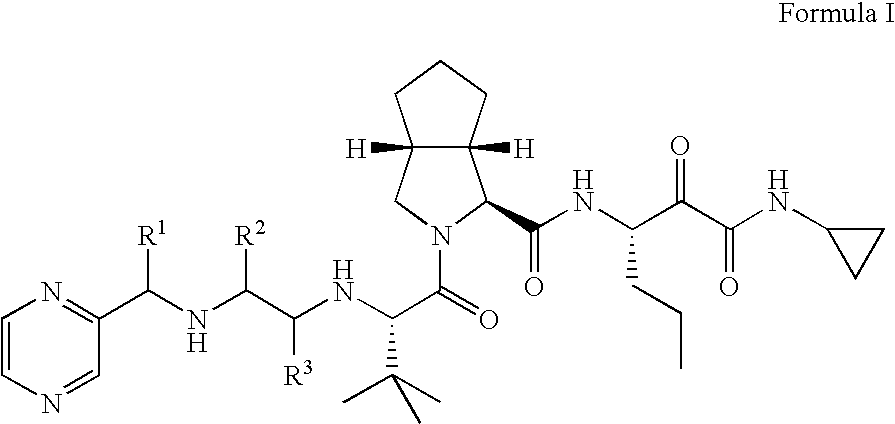Substituted pyrazines that inhibit protease cathepsin S and HCV replication
a technology of protease cathepsin and substituted pyrazines, which is applied in the field of substituting pyrazines that inhibit protease cathepsin s and hcv replication, can solve the problems of retinopathy, severe side effects, and high risk, and achieves the effects of reducing the risk of retinopathy, and reducing the number of hcv replication
- Summary
- Abstract
- Description
- Claims
- Application Information
AI Technical Summary
Benefits of technology
Problems solved by technology
Method used
Image
Examples
examples
[0125]The present invention is further exemplified, but not limited by, the following preparations and examples that illustrate the preparation of intermediates and compounds of Formula I according to the invention.
preparation 1
Preparation of (3S)-3-amino-N-cyclopropyl-2-hydroxyhexanamide hydrochloride, the compound of Formula (12)
[0126]
Step 1
[0127]To a mixture of Boc-NVa-OH (25 g, 0.115 mol), N,O-dimethylhydroxyamine hydrochloride (12.34 g, 0.127 mol), 1-ethyl-3-(3′-dimethylaminopropyl)carbodiimide (33.07 g, 0.173 mol) and 1-hydroxybenzotriazole (22.9 g, 0.15 mol) in dichloromethane (300 mL), was slowly added N-methylmorpholine (34.9 g, 0.35 mol) under stirring over a 30 minute period. The reaction was stirred at room temperature for 2 hours, then diluted with 2000 mL ethyl acetate, washed with a saturated aqueous solution of sodium bicarbonate, water, and brine, and dried over magnesium sulfate. The solvent was removed under reduced pressure to provide [1S-(methoxymethylcarbamoyl)butyl]carbamic acid tert-butyl ester (20 g) as a colorless oil.
Step 2
[0128]To a solution of [1S-(methoxymethylcarbamoyl)butyl]carbamic acid tert-butyl ester (7.2 g, 27.7 mmol) in anhydrous tetrahydrofuran (100 mL) under argon at...
preparation 2
Preparation of (1S,3aR,6aS)-ethyl octahydrocyclopenta[c]pyrrole-1-carboxylate hydrochloride, the Compound of Formula (9)
[0132]
Step 1
[0133]A solution of benzylamine (6.4 mL) and tetrahydro-1H-cyclopenta[c]furan-1,3(3aH)-dione (8 gm) in tetrahydrofuran (28 mL) was heated under reflux for 18 hours. After cooling to room temperature, the reaction mixture was diluted with ethyl acetate, and filtered through a pad of celite. Evaporation under reduced pressure gave crude (3aR,6aS)-2-benzyltetrahydrocyclopenta[c]pyrrole-1,3(2H,3 aH)-dione.
Step 2
[0134]The product from step 1 was dissolved in tetrahydrofuran and added to a 1M solution of lithium aluminum hydride in tetrahydrofuran at 0° C. The mixture was refluxed for 18 hours, then cooled to 0° C., and the excess lithium aluminum hydride quenched by cautious addition of water. Filtration through a pad of celite and evaporation of the filtrate under reduced pressure gave crude product, (3aR,6aS)-2-benzyl.octahydrocyclopenta[c]pyrrole.
Step 3
[0...
PUM
| Property | Measurement | Unit |
|---|---|---|
| pressure | aaaaa | aaaaa |
| temperature | aaaaa | aaaaa |
| temperature | aaaaa | aaaaa |
Abstract
Description
Claims
Application Information
 Login to View More
Login to View More - R&D
- Intellectual Property
- Life Sciences
- Materials
- Tech Scout
- Unparalleled Data Quality
- Higher Quality Content
- 60% Fewer Hallucinations
Browse by: Latest US Patents, China's latest patents, Technical Efficacy Thesaurus, Application Domain, Technology Topic, Popular Technical Reports.
© 2025 PatSnap. All rights reserved.Legal|Privacy policy|Modern Slavery Act Transparency Statement|Sitemap|About US| Contact US: help@patsnap.com



